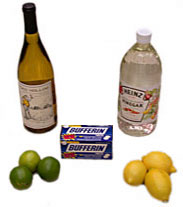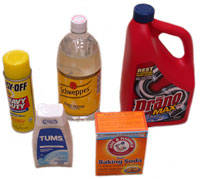| |
INTRODUCTION
Acids and bases in our lives
Acids and bases are two broad classes of compounds that have a great deal of
importance in both chemistry and biochemistry. In industry, acids and bases
are used in various reactions. Sulfuric acid, one of the most important industrial
chemicals, is used to manufacture fertilizers for agriculture, to make man-made
fibers, paints and dyes, and to purify petroleum products. The base sodium hydroxide
(sometimes called caustic soda, or lye) is used for the production of fabrics,
paper, and cleaning agents.
 |
| Acids are sour or tart: vinegar, lemon and orange juice, wine, aspirin. |
|
Acids and bases are also common in our everyday lives. Acids have a sour taste,
and many of the sour-tasting foods with which we are familiar are acidic. Vinegar,
for example, is diluted acetic acid (normal household vinegar is a 3% solution
of acetic acid), and gives salad dressings and pickled vegetables their tart tastes.
Other familiar foods with sour flavors get their tartness from acids: oranges
and lemons contain citric acid, wine contains tartaric acid, and aspirin contains
acetylsalicylic acid.
While the tart taste of some acids can be a pleasant addition to many kinds
of foods, bases have a bitter flavor, and therefore are not typically preferred
for human consumption. However, many people have acquired tastes for caffeine
and nicotine, both of which are alkaloids, a class of nitrogen-containing bases.
Quinine, the ingredient that gives tonic water its bitter taste, is also an
alkaloid. Antacids, including sodium bicarbonate (baking soda) and calcium carbonate
(Tums), are basic and work by neutralizing stomach acids to water and carbon
dioxide (CO2) gas. Bases feel slippery because they are soapy in
nature, which is why they are used in cleaners. Lye (sodium hydroxide), a strong
base, can dissolve grease and protein, and is used in oven cleaners, products
for unclogging drains, and in hair-removal lotions.
 |
| Bases are bitter: coffee, cigarettes, tonic water, baking soda, antacid tablets, soap. |
|
Acids and bases are also essential for life. For example, without the strong
acid present in our stomachs, we would not be able to digest food. More importantly,
an organism needs to be able to control the level of acid within its cells for
life to be possible. The world’s oceans are able to sustain life in part
because the level of acid (or pH) of the water is kept constant through acid–base
chemistry. In the same way, the pH of living cells is tightly regulated to allow
cells to maintain their structural integrity, and for cellular processes to function.
To keep living cells or body fluids at the proper pH, special compounds called
buffers are used. A solution containing a buffering agent tends to resist
changes in pH, so that biochemical reactions, which often produce or use up acids,
can proceed without producing wild fluctuations in cellular pH. In this way, the
whole cell is protected from high concentrations of acid, but critical acid–base
reactions can still proceed in the cell. Since pH is so critical to biological
molecules, any biochemical experiment that involves studying proteins or cellular
systems needs to be performed in a buffered solution to keep the molecules in
their natural, or native, conformation. Thus, an understanding of how buffers
can help regulate pH is essential for any biochemist.
Learning objectives
- Learn the definitions of acid, base, and pH.
- Know how to convert from [H+] to pH and vice versa.
- Understand the meaning of Ka and pKa.
- Know how to use the Henderson–Hasselbalch equation.
- Learn how buffers work.
|

